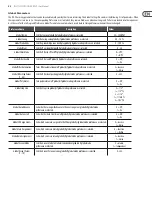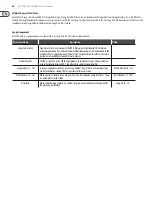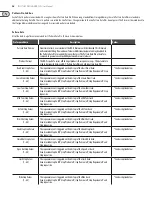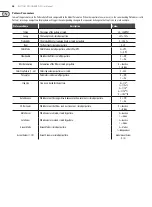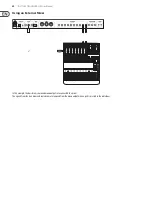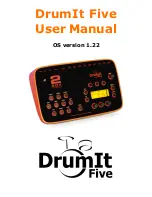
35
RHYTHM DESIGNER RD-9 User Manual
17. Glossary
RD-9 GLOSSARY
This glossary provides an explanation of useful symbols, terms and abbreviations.
AC:
Alternating Current
Analog:
Something which is proportional or similar to something else. In
the case of the drum machine, audio electronic circuits are another form of
air pressure waves. Analog signals contain distortions from the components,
topology, circuits and designs which are often perceived as warmer and more
natural than their digitally generated counterparts.
Attack:
Increase or decrease the initial transient of the signal.
Auto Scroll:
Follows the play head to show current step position.
Balanced Audio:
A type of audio connection that uses the three wires in a cable
as part of a phase-cancelling arrangement to boost the signal and reduce noise.
Bass:
Lower frequencies in a signal ranging from 60 Hz to 250 Hz (Approximately
B1 to B3).
Beats Per Minute (BPM):
Used to describe the tempo of a composition by
specifying the number of beats which should occur in every minute.
Cent:
Unit of measurement for pitch tuning. There are one hundred cents in a
semitone.
Chain:
A function to link songs or pattern information together.
Control Voltage (CV):
A voltage signal used to control any parameter. This was
common on drum machines before the advent of MIDI.
Cut-Off Frequency:
The frequency which a filter is set to. Beyond this frequency
(in a low-pass filter, the most common), the sound is cut off (attenuated) at a rate
set by the slope of the filter response curve.
Default:
An initial value for parameter, i.e., the value before any changes have
been made.
Digital Audio Workstation (DAW):
A computer-based recording system. More
commonly used to describe the software package used to record, process and
mix.
Dump:
To send (dump) the contents of the memory of the device over the MIDI
cables as "SysEx" information.
Flam:
The simulated effect of a drummer hitting a note with 2 sticks. The
amount of flam dictates the length of time between the next hit after the first.
Filter:
A device that attenuates certain frequencies while letting other
frequencies through. Using a filter to reduce harmonics, changes the timbre or
colour of the sound.
Gain:
The amount of signal level increase provided by an amplifier stage.
Gate (Synthesizer):
A signal used to trigger an event, such as a note or an
envelope.
Gate (Dynamics):
A device used to cut off the level of a signal when it falls
below a specified threshold. Can be used to cut background noise, control reverb
tails, or creatively to produce chopping type effects.
Global:
The settings and parameters which govern the general operation of the
drum machine and are not directly associated with the voice engines.
Harmonics:
A series of integer-related sine waves at varying levels creating
different timbres. Waveforms (other than a pure sinusoidal) generate various
harmonics which help define the character of the sound.
Hertz (Hz):
A unit of frequency equal to one cycle of a wave per second.
High Pass Filter (HPF):
A filter that attenuates lower frequencies from a signal,
leaving the higher frequencies unaffected.
Hum:
Undesirable low-frequency tone (typically 50 or 60 Hz) present in a signal
due to grounding problems or proximity to a power source or power cables.
Impedance (Z):
Opposition to the flow of alternating current in a circuit,
measured in Ohms.
Kilohertz (kHz):
A unit of frequency equal to one thousand cycles of a wave per
second.
Latency:
A delay introduced by processing. Measured by the time it takes to
produce a signal after a request has been made. In a synthesizer, it is the time
taken to produce a note after a key has been played. In an audio interface, it is
used to measure the time it takes for an input signal to reach the processor, or for
a signal from the processor to reach the output.
Level:
Used to describe the magnitude of a sound, often relative to an arbitrary
reference.
Length:
Defines the number of steps in a pattern.
Line Level:
A nominal operating level used by audio equipment. Professional
line level is no4 dBu and consumer line level is -10 dBu.
Looping:
Automatically restarting a function at the end of a period of time or
defined cycle, to create a continuous loop.
Low Pass Filter (LPF):
A filter that attenuates higher frequencies from a signal,
leaving the lower frequencies unaffected.
Map:
How MIDI note numbers are assigned to voices.
Master:
Overall volume control.
Meter:
Visual device to indicate the level of a signal.
MIDI (Musical Instrument Digital Interface):
A technical standard that
describes a protocol, digital interface and connectors and allows a wide variety of
electronic musical instruments, computers and other related hardware/software
devices to connect and communicate.
MIDI Clock:
A clock signal which is broadcast over MIDI to ensure that devices
are synchronized. Also known as MIDI Beat Clock or MIDI Timing Clock.
MIDI Message:
Data or information transmitted from one MIDI device to
another. Each MIDI message contains at least two numbers: one that identifies
the type of message being sent, and another which represents a value for the
selected type of message.
Midrange:
Frequencies in a signal ranging from 250 Hz to 5 kHz (Approximately
B3 to D#8).
Mix:
The balance of level between one signal and another.
Mixer:
A device that blends input signals into composite signals for output.
Mode:
The selection of song, pattern or step edit.
Monitors:
Studio quality loudspeakers, providing an accurate representation of
the audio signals.
Mono:
A single signal.
Mute:
Function that allows a signal to be silenced.
N/A:
Abbreviation for "not applicable" or "not available".
Ohm (Ω):
Unit of electrical resistance.
Summary of Contents for RD-9
Page 38: ...We Hear You ...



